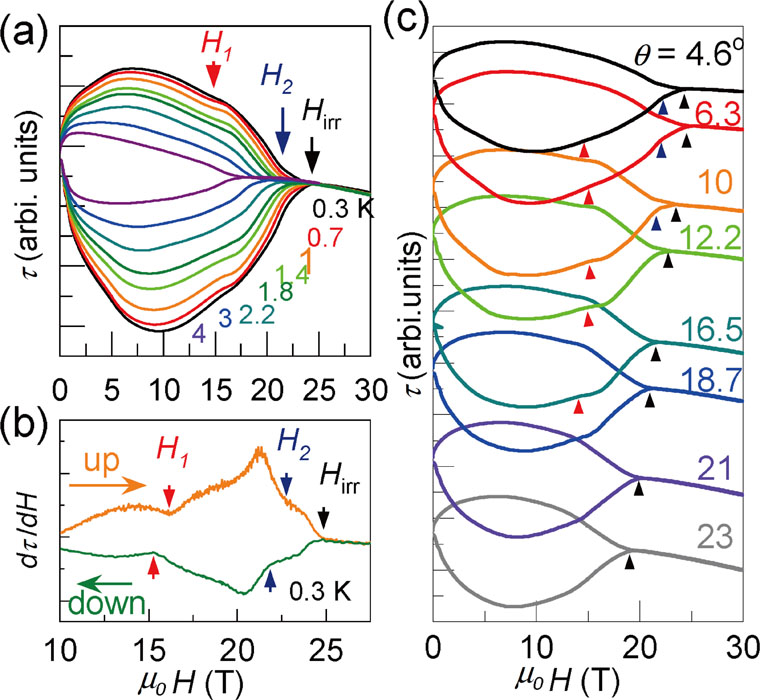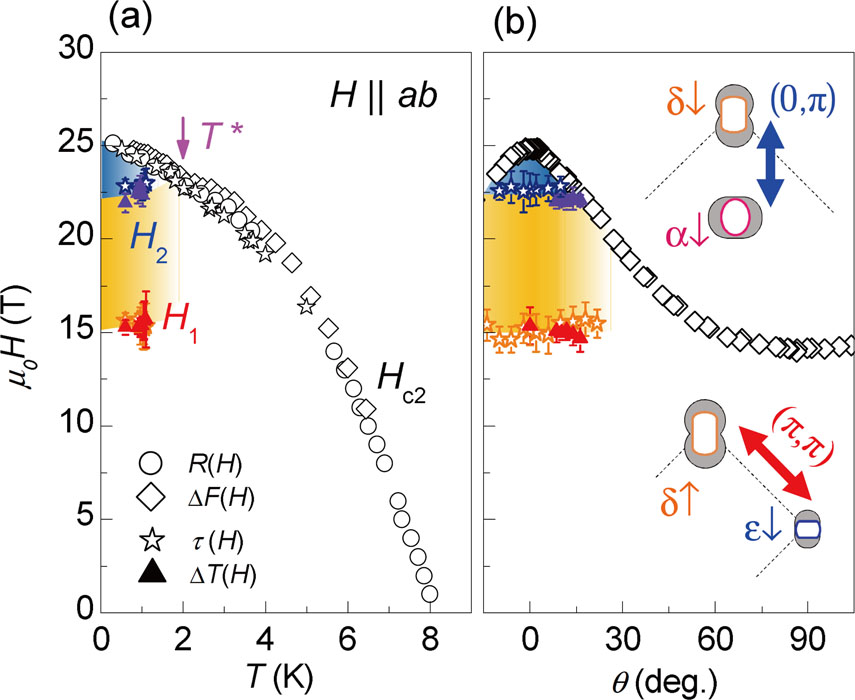Observation of In-Plane Magnetic Field Induced Phase Transitions in FeSe
J. S. Kim, Y. Kohama, and J. M. Ok
In conventional superconductors, spin polarization can destroy superconductivity when Zeeman energy surpasses the binding energy of Cooper pairs, known as the Pauli paramagnetic limit. Beyond the Pauli limit, exotic superconducting phases, often coexisting with complex magnetic orders, have been observed in some unconventional superconductors. Even in these cases, however, field-induced spin imbalance is usually at most a few %. So far, realization of the highly spin-imbalanced superconductivity and possible field-induced exotic phases have been remained elusive, partly due to the lack of the suitable material candidates.
FeSe is a promising candidate hosting a strongly spin imbalanced state at high magnetic fields. The observed in-plane upper critical field of FeSe is Hc2ab ≈ 25 T, well above the conventional BCS value of the Pauli limiting field HP ≈ 15.6 T (HP = 1.84 Tc), and the Zeeman energy at Hc2 becomes comparable with the superconducting gap ΔSC (μBHc2 ~ ΔSC). In addition, high-quality FeSe single crystals are found to be in the clean limit with a much longer mean free path l than the superconducting coherence length ξ (l >> ξ). More importantly, FeSe is in the so-called BCS-BEC (Bose-Einstein condensate) crossover regime (ΔSC~EF) with exceptionally small Fermi energies. The spin imbalance reaches up to ~ 40% for one of the Fermi surfaces (FSs) at Hc2ab ≈ 25 T, much larger than the typical value of a few % in other superconductors. Therefore, FeSe can be a model system to study whether, and if so how, competing magnetic or superconducting instabilities trigger exotic field-induced phases in multiband superconductors with a large spin imbalance.
In this work, using torque magnetometry, specific heat, and magnetocaloric measurements, we identified successive anomalies with increasing in-plane magnetic field, below Hc2 at low temperatures and in the clean limit. The signatures of unusual phase transitions below Hc2ab and below T*≈ 2 K are observed in the field-dependent torque magnetometry τ (H). The torque magnetometry in superconductors usually exhibits a typical saw-tow shaped curve of the field derivative τ (H), dτ/dH due to vortex pinning. In FeSe, however, we observed two additional anomalies at H1~15 T and H2~22 T, well below the irreversible field Hirr at which the hysteresis in τ (H) starts to develop (Fig. 1a and 1b). The transition fields H1 and H2 follow the distinct dependence on temperature or field angle from those of Hirr ≈ Hc2 (Figs. 1a and 1c). Upon increasing temperature or the tilting angle of the magnetic field (θ) from H || ab, Hirr systematically decreases, similar to Hc2. In contrast, the anomalies are pronounced only at low temperatures below T* and near H || ab with θ ≤ 15o. Also, the transition fields H1 and H2 remain almost the same with variation of temperature or field angle (Figs. 2a and 2b). The anomalies seen in torque magnetometry are further confirmed by magnetocaloric and specific heat measurements [1]. These findings clearly evidence the presence of field-induced phases near the in-plane magnetic fields below Hc2ab.

Fig. 1. (a) Magnetic field dependent torque τ (H) close to H || ab at various temperatures. The irreversibility field at Hirr ~ 25 T and anomalies at H1 ~ 15 T and H2 ~ 22 T are indicated by black, red and blue arrows, respectively. (b) The field-derivative curve dτ(H)/dH showing clear anomalies at H1 and H2. (c) Magnetic field dependent torque τ (H) at various field angles.

Fig. 2. (a,b) Magnetic phase diagram of FeSe for H || ab as a function of temperature (a) and field orientation (θ) with respect to the ab plane (b). The upper critical field Hc2ab (T) (open symbols) are determined by resistivity (black open circle), TDO frequency (black open diamond), and torque magnetometry (black open star) measurements, while the field-induced phase transitions at H1 and H2 are obtained by torque magnetometry (colored open star) and the magnetocaloric effect (colored solid triangle). The inset shows schematics of the possible nesting effect via q = (0, π) or (π, π) between the spin-split Fermi surfaces (FSs) with anisotropic superconducting gap (gray shade). Near H1, the nesting effect is expected between two FSs with opposite spins via a SDW momentum q = (π, π) (bottom), while the nesting with q = (0, π) is expected near H2 between two FSs with the same spins (top).
One possible candidate for the high field anomalies is then the FFLO phase. In this case, the Cooper-pair state (k↑, −k+q↓) is formed with a momentum mismatch (q) between the spin-split FSs. In multiband superconductors, each FS has its own FFLO instability with a different modulation length qi−1 (i, band index), and these instabilities compete with each other, inducing the multiple FFLO orders at different magnetic fields. Alternatively, the spin-density wave (SDW) phase of field-induced quasiparticles can be another promising candidate. When the superconductivity is suppressed by Pauli pair breaking near the superconducting gap nodes or minima, the SDW order can be triggered by the nesting effect by field-induced quasiparticles. Due to an exceptionally small EF, the Zeeman effect results in the spin-split FSs much different in size, which significantly affects the nesting condition in FeSe. We found that the nesting via q = (π, π) nicely matches the two different FSs with opposite spins at H~16 T, and with the same spins at H~22 T (Fig. 2b). in good agreement with the observed transition fields, H1 and H2. The incipient spin fluctuations and strong coupling between the field-induced quasiparticles may allow the coexisting phase with the SDW and superconductivity.
In the current stage, the detailed nature of the field-induced phase transitions, including possible coexistence of the SDW and the FFLO orders, remains to be clarified. Nevertheless, these observations clearly demonstrate that FeSe offers a unique system, in which field-induced phase transitions occur in the superconducting state. This poses a challenge to our understanding on the complex interplay between anisotropic superconducting order, incipient magnetic instabilities, and the multi-band effect in the largely spin-imbalanced superconducting systems.
References
- [1] J. M. Ok, C. I. Kwon, Y. Kohama, J. S. You, S. K. Park, J. Kim, Y. J. Jo, E. S. Choi, K. Kindo, W. Kang, K.-S. Kim, E. G. Moon, A. Gurevich, and J. S. Kim, Phys. Rev. B 101, 224509 (2020).
